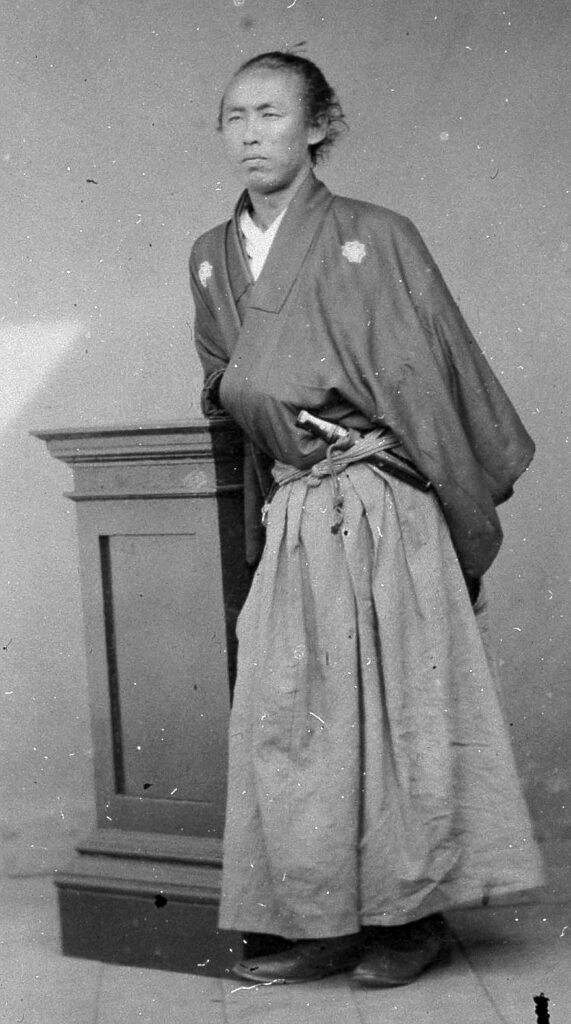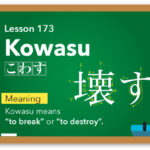

坂本龍馬 SAKAMOTO Ryoma
1835 – 1867
Born in the Richest Merchant Family in Tosa
Sakamoto Ryoma was born in 1835 in Tosa (Kochi prefecture) as the 5th youngest child. He was a crybaby when he was a child and was very close to his three-year-older sister. His family belonged to a low-ranked class, which had to give in to upper-ranked people. However, since the Sakamoto family ran many businesses, such as pawnshop, brewing companies, and clothes shops, and had settled a lot of money, they were able to live in luxury. Ryoma was also very blessed with his talent for swordplay, which he was able to travel to Edo to study more about. It was like what is now called a “studying abroad program.”
Witnessed the Arrival of the Black Ships
In 1853, the black ships of the United States Navy arrived at Uraga, Edo. The expedition was commanded by Matthew Calbraith Perry. The goal was to force Japan to end its 220-year-old isolation policy and to open Japanese ports for American trading ships through the use of gunboat diplomacy. Ryoma, as a 19-year-old, went to the port as a soldier and witnessed the overwhelmingly large and strong American ships, and the loud sounds of their cannons shocked and inspired Ryoma a lot. He strongly felt that Japan needed to be changed to protect itself from the foreign countries that were way ahead of Japan in power, technology, and system. Ryoma also recognized that the Japanese’s use of swords was outdated, as his iconic line states “There is no way to beat foreign countries with swords”. After that, he went back to Tosa to see Kawada Shoryu, who knew a lot about the foreign countries. Shoryu passed on his knowledge about the menace of foreign countries and gave Ryoma advice on how Japan needed to grow along with other strong foreign countries.
The Apprentice of Kaishu
When Ryoma was 27 years old, he joined a social group called, Tosa-kinnou-tou, which admired the emperor and believed that they could drive foreign ships away with military forces. The leader of this group was Ryoma’s childhood friend, Takechi. Ryoma and people from Tosa-kinnou-tou worked hard and killed anyone who had disagreed with them, and gained power and recognition. One day, Ryoma was heading to Edo to kill Katsu Kaishu, for Kaishu was encouraging Japan to open the country. This was the perfect day for Ryoma to use his gifted skill of swordplay. However, Kaishu told Ryoma, “Let’s talk about it before you just kill me,” and continued to explain to Ryoma what his plan was for Japan’s future. Kaishu was able to convince Ryoma that since Japan was not strong enough to fight back against other countries, it was a smart idea to open the country up for new inspirations regarding technology and knowledge from foreign countries, which made Ryoma change his mind on him and ended up becoming Kaishu’s apprentice.
As time passed, Ryoma realized the gap between the leader of Tosa-kinnou-tou, Takechi, and himself. While Takechi was getting too aggressive to behave radically, Ryoma started to feel that staying with him may be a waste of time as they would spend most of their time fighting each other rather than uniting. Ryoma did not think that the violent way the Tosa-kinnou-tou act would change Japan. At this time, Ryoma had left not only the Tosa-kinnou-tou but his hometown to work with Kaishu. Ryoma leaving his hometown was a serious crime, with many risks of being killed, as people considered people leaving a betrayal towards their hometown and people back then. Ryoma was serious to work with Kaishu to end Edo Shogunate and open the country that he risked his own life.
The Blossom of the Talent of Business
At that time, Japan was targeted by foreign countries. Ryoma thought in order to protect Japan, it was necessary to turn Japan into a new and stronger country where the Imperial Court played a central role in politics on behalf of the Edo Shogunate. The first step was to make Satsuma (Kagoshima Prefecture) and Choshu (Yamaguchi Prefecture), the two biggest powers of Japan, and to be aligned with each other so that they have the one great power to end the Edo Shogunate. However, Satsuma and Choshu were on bad terms. At the age of 31, Ryoma launched “Kameyama Shachu” in Nagasaki, which is said to be the first trading company in Japan. They imported arms, such as guns and cannons to sell Satsuma, who wanted to make money by selling arms and let Choshu, who wanted to buy arms but was not able to buy them, to buy them from Satsuma. Kameyama Shachu made a mutually beneficial relationship for both Satsuma and Choshu. Finally, Ryoma succeeded in fixing the relationship between them. Remember Ryoma was born in a merchant home? Ryoma had the talent of business and technique to accomplish one of the biggest events in Japanese history.
Kimono × Boots
Ryoma’s fashion had always been kimono and boots. At this time, there was a rule that low-ranked samurais were only allowed to wear Zori sandals. Ryoma, who was low-ranked, hated that class system, so he enjoyed boots that he could wear in Nagasaki, which was called the overseas Japan.
Ryoma’s Romance and the Honeymoon
Since Ryoma took actions such as leading Satsuma and Choshu to be partnered and launching the Kameyama Shachu, he eventually had gotten very popular. Many people respected and supported Ryoma, but at the same time, other people were trying to catch and kill him. One day, when Ryoma was in a hotel called Teradaya in Kyoto, he got attacked by an official of the Shogunate, which seriously injured him. At that time, there was a woman, who informed that an official was coming to protect Ryoma. Ryoma married her (her name was Ryo-san) and went on a trip to the hot springs in Satsuma. It is said that Ryoma and Ryo-san were the first couple in Japan who took a honeymoon trip.
Eight Plans for the Future of Japan
Ryoma was also thinking about how Japan should improve after the collapse of the Edo Shogunate. On the Tosa’s ship, Ryoma told Goto Shojiro about eight plans that he came up with and his desire for rebuilding a new Japan. Those plans are called “Senchu-Hassaku,” which means the eight plans stated in a ship, and these ideas are the basis of the mechanism of modern Japan. These important plans include the system of parliamentary politics, creating a constitution, and a change of gold and silver exchange rate. In October 1867, Yoshinobu Tokugawa, the 15th shogun of the Edo Shogunate, decided to return the political rights to the Imperial Court. The era of the Edo Shogunate was finally over.
The Biggest Mystery in Japanese History
A month after the Edo Shogunate ended and a new Japan was just about to begin to form, Ryoma got attacked on November 15th, his 33rd birthday, at a hidden house called Omiya in Kyoto. It had been five years since he left Tosa to work to open the country in earnest. Ryoma, who made the greatest achievements during the 33 short years of his life, became a star without being able to see the new appearance of Japan. Ryoma is one of the most respected and famous historical figures who worked to create Japan by ending the Edo Shogunate and opening the country.
.
.
.




